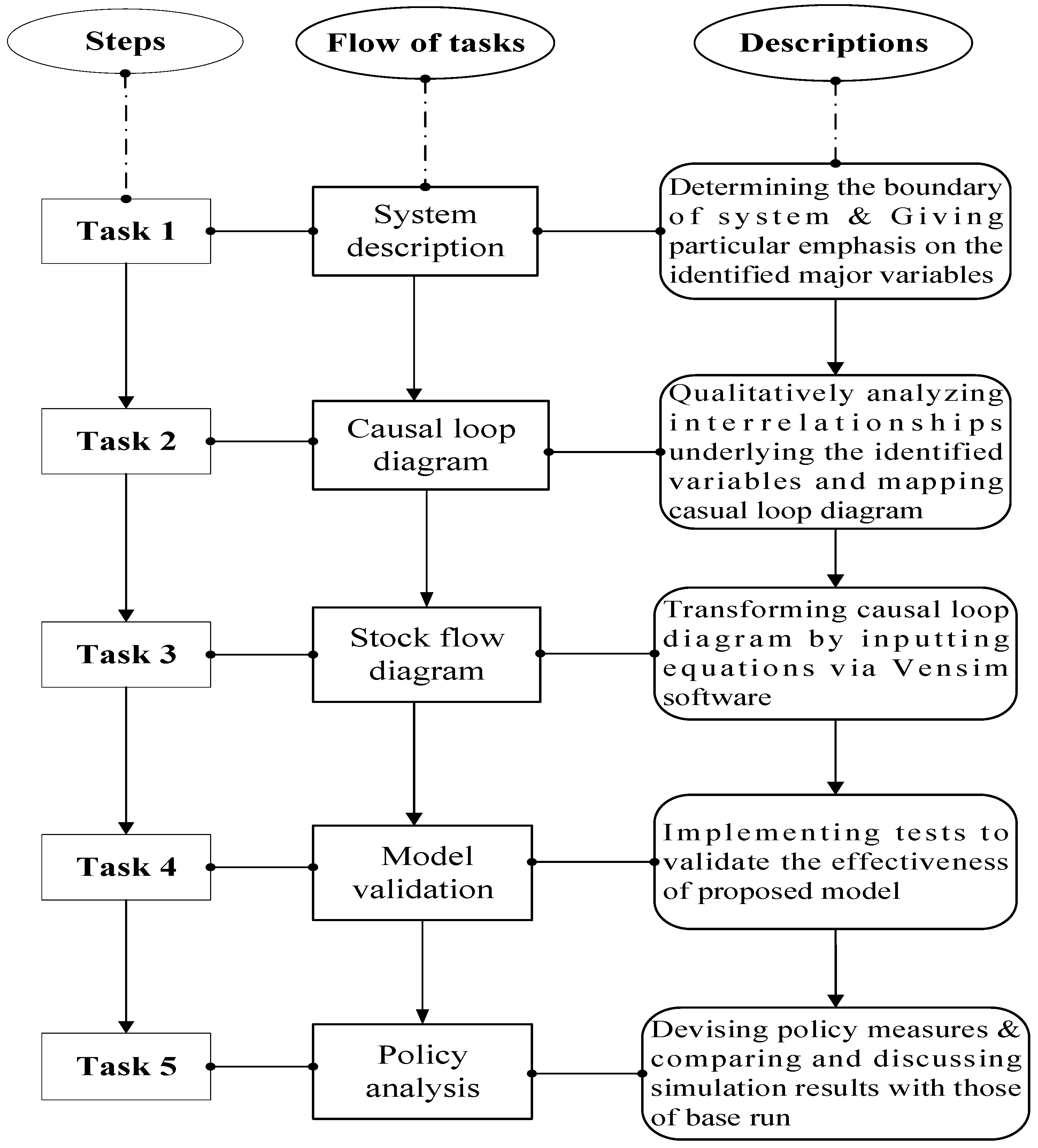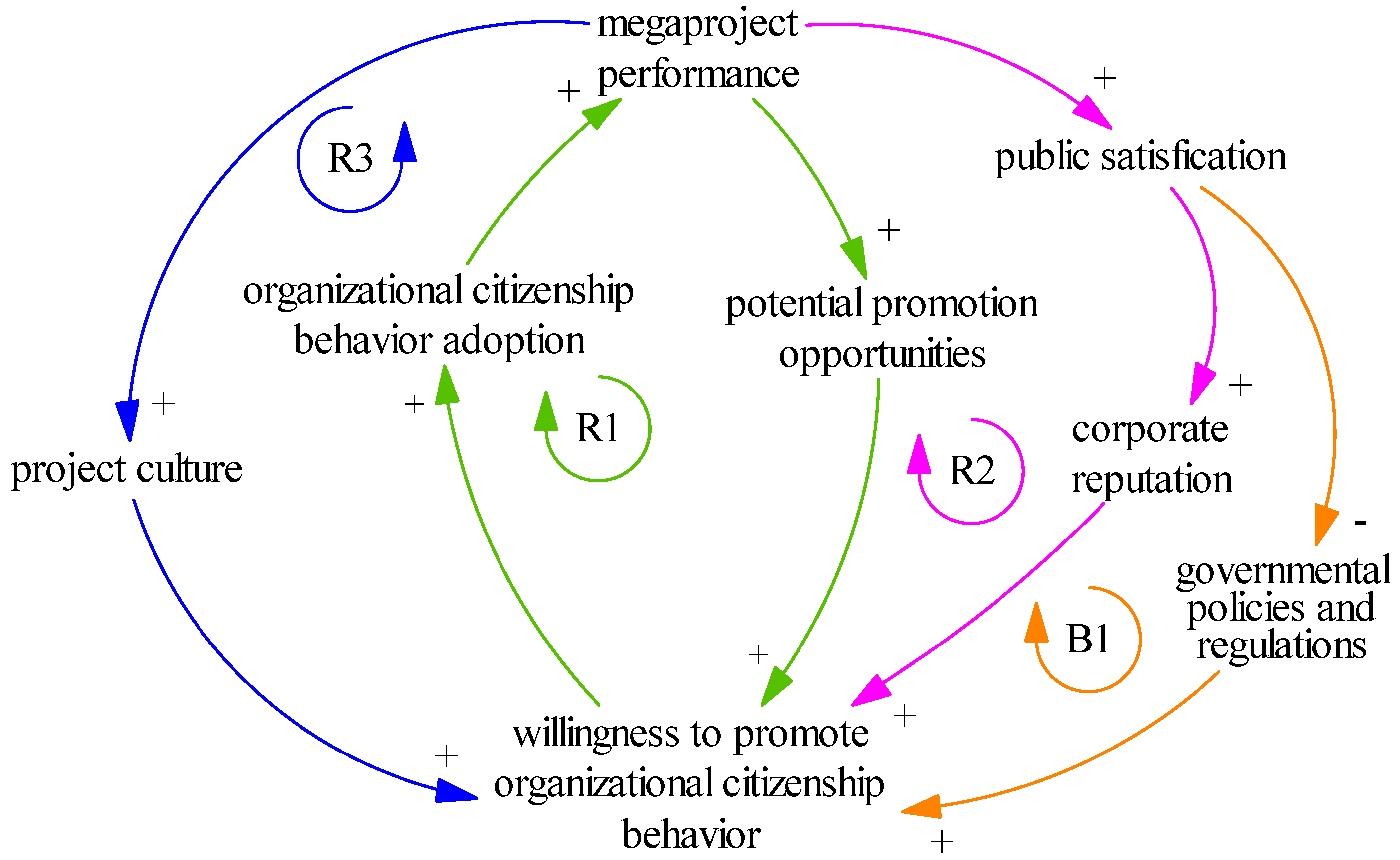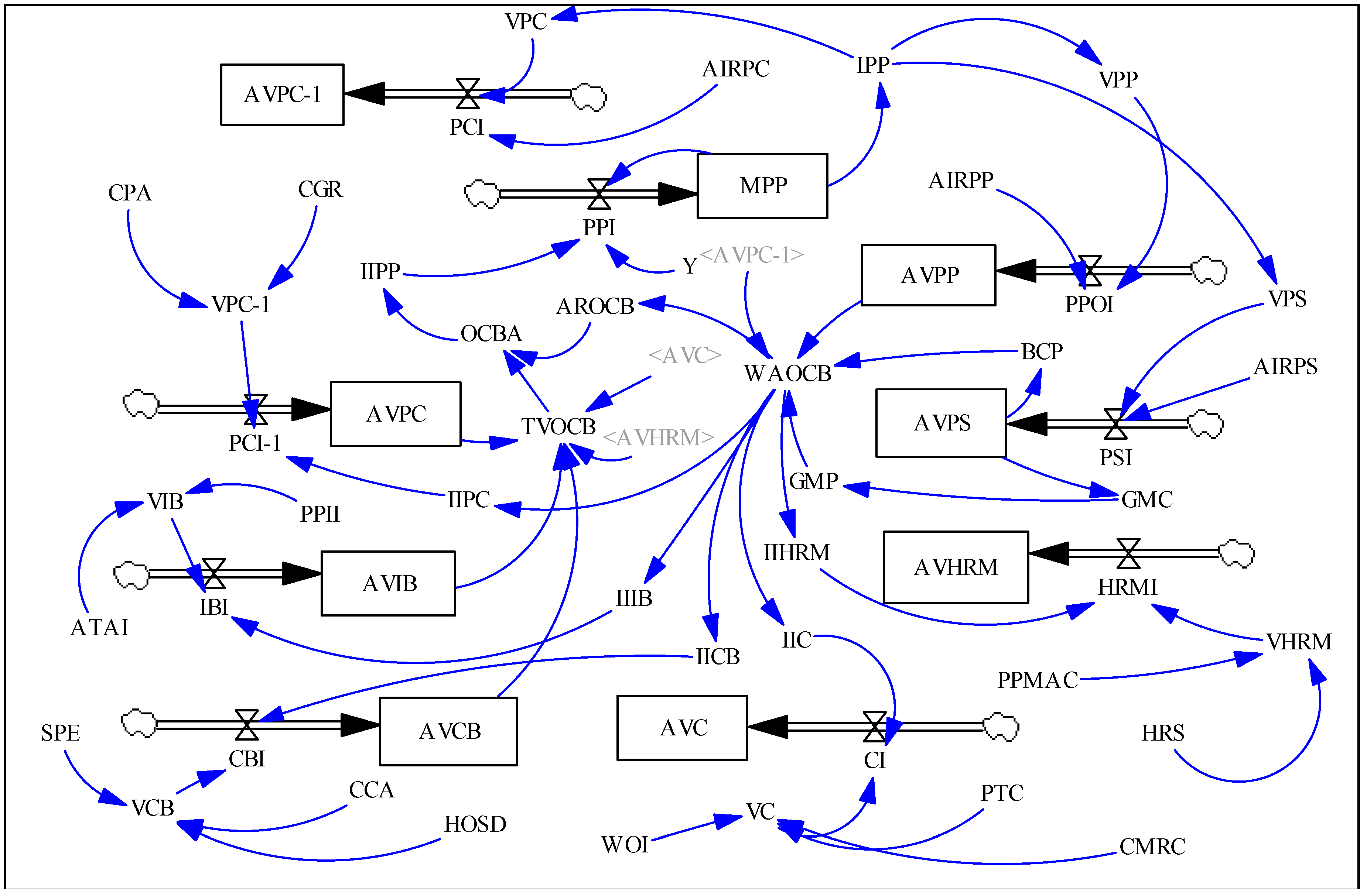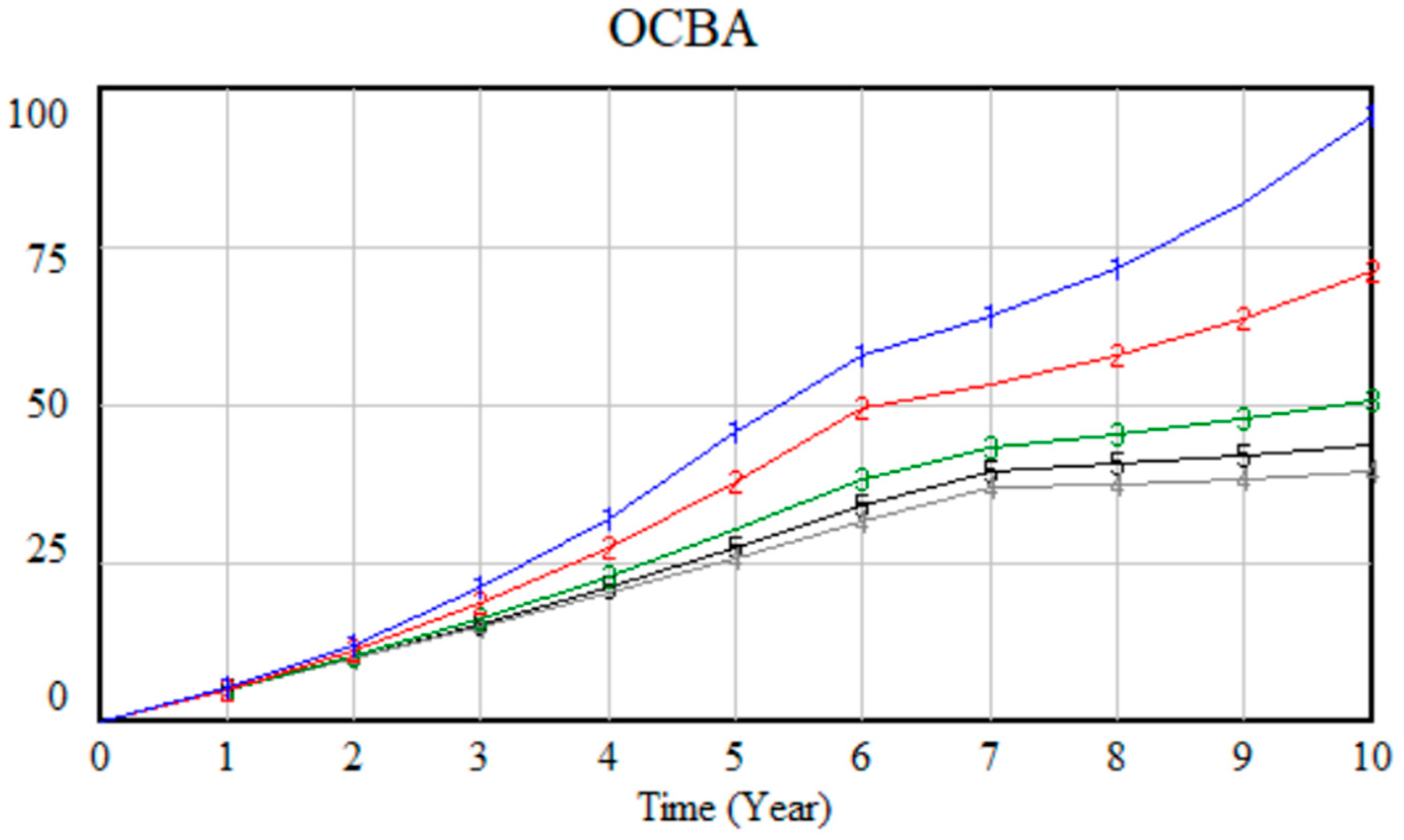How Does Organizational Citizenship Behavior (OCB) Affect the performance of megaprojects? Insights from a System Dynamic Simulation
Abstract
:1. Introduction
2. Literature Review
3. Model Development
3.1. Steps of Model Development
3.2. Causal Loop Diagram
3.3. Stock-Flow Diagram
4. Model Validation
5. Policy Analysis
5.1. Results of Base Scenario
5.2. Results of Policy Scenarios
5.2.1. Single-Policy Scenario
5.2.2. Scenario C: Dual Effects
6. Conclusions
Author Contributions
Funding
Acknowledgments
Conflicts of Interest
Appendix A
| Acronym | Descriptions | Variable Type | Acronym | Descriptions | Variable Type |
|---|---|---|---|---|---|
| AIRPC | Actual increasing rate of project culture | Constant | IIHRM | Increasing index of harmonious relationship maintenance | Auxiliary |
| AIRPP | Actual increasing rate of potential promotion | Constant | IIIB | Increasing index of innovation behavior | Auxiliary |
| AIRPS | Actual increasing rate of public satisfaction | Constant | IIPC | Increasing index of project compliance | Auxiliary |
| AROCB | Adoption rate of organizational citizenship behavior | Auxiliary | IIPP | Increasing index of project performance | Auxiliary |
| ATAI | Advanced technology adopted initiatively | Constant | IPP | Increasing index of project performance | Auxiliary |
| AVC | Accumulated value of conscientiousness | Stock | OCBA | Organizational citizenship behavior adoption | Auxiliary |
| AVCB | Accumulated value of collaboration behavior | Stock | PCI | Project culture increment | Flow |
| AVHRM | Accumulated value of harmonious relationship maintenance | Stock | PCI-1 | Personal compliance increment | Flow |
| AVIB | Accumulated value of innovation behavior | Stock | MPP | The performance of megaprojects | Flow |
| AVPC | Accumulated value of project compliance | Stock | PPI | Project performance increment | Stock |
| AVPC-1 | Accumulated value of project culture | Stock | PPII | Project program improved initiatively | Constant |
| AVPP | Accumulated value of potential promotion | Stock | PPMAC | Conscious participation in project meetings and activities | Constant |
| AVPS | Accumulated value of public satisfaction | Stock | PPOI | Potential promotion opportunities increment | Flow |
| BCP | Benefits of corporate reputation | Auxiliary | PSI | Public satisfaction increment | Flow |
| CBI | Collaboration behavior increment | Flow | PTC | Participation in training consciously | Constant |
| CCA | Coordination conflicts actively | Constant | SPE | Shares with project experience | Constant |
| CGR | Compliance with governmental requirements on the project | Constant | TVOCB | Total value of organizational citizenship behavior | Auxiliary |
| CI | Conscientiousness increment | Flow | VC | Value of conscientiousness | Auxiliary |
| CMRC | Conduct mission requirements consciously | Constant | VCB | Value of collaboration behavior | Auxiliary |
| CPA | Compliance with project arrangements | Constant | VHRM | Value of harmonious relationship maintenance | Auxiliary |
| GMC | Governmental management changing | Auxiliary | VIB | Value of innovation behavior | Auxiliary |
| GMP | Governmental management performance | Auxiliary | VPC | Value of project culture | Auxiliary |
| HOSD | Helps others to solve the difficulties | Constant | VPC-1 | Value of project compliance | Auxiliary |
| HRMI | Harmonious relationship maintenance increment | Flow | VPP | Value of potential promotion | Auxiliary |
| HRS | Harmonious relationship with stakeholders | Constant | VPS | Value of public satisfaction | Auxiliary |
| IBI | Innovation behavior increment | Flow | WAOCB | Willingness to adopt organizational citizenship behavior | Auxiliary |
| IIC | Increasing index of conscientiousness | Auxiliary | WOI | Work overtime initiatively | Constant |
| IICB | Increasing index of collaboration behavior | Auxiliary | Y | Yearly | Constant |
Appendix B
References
- Flyvbjerg, B. What You Should Know About Megaprojects and Why: An Overview. Proj. Manag. J. 2014, 45, 6–19. [Google Scholar] [CrossRef]
- He, Q.; Luo, L.; Hu, Y.; Chan, A.P.C. Measuring the complexity of mega construction projects in China—A fuzzy analytic network process analysis. Int. J. Proj. Manag. 2015, 33, 549–563. [Google Scholar] [CrossRef]
- Hu, Y.; Chan, A.P.C.; Le, Y.; Jin, R.-Z. From Construction Megaproject Management to Complex Project Management: Bibliographic Analysis. J. Manag. Eng. 2015, 31, 1–11. [Google Scholar] [CrossRef]
- Podsakoff, P.M.; MacKenzie, S.B.; Paine, J.B.; Bachrach, D.G. Organizational Citizenship Behaviors: A Critical Review of the Theoretical and Empirical Literature and Suggestions for Future Research. J. Manag. 2000, 26, 513–563. [Google Scholar] [CrossRef]
- Nielsen, T.M.; Hrivnak, G.A.; Shaw, M. Organizational Citizenship Behavior and Performance: A Meta-Analysis of Group-Level Research. Small Group Res. 2009, 40, 555–577. [Google Scholar] [CrossRef]
- Song, Y.; Tan, Y.; Song, Y.; Wu, P.; Cheng, J.C.P.; Kim, M.J.; Wang, X. Spatial and temporal variations of spatial population accessibility to public hospitals: A case study of rural–urban comparison. GISci. Remote Sens. 2018, 55, 1–27. [Google Scholar] [CrossRef]
- Xing, X.; Chalip, L. Marching in the Glory: Experiences and Meanings When Working for a Sport Mega-Event. J. Sport Manag. 2009, 23, 210–237. [Google Scholar] [CrossRef]
- Yang, D.; He, Q.; Cui, Q.; Hsu, S.-C. Organizational Citizenship Behavior in Construction Megaprojects. J. Manag. Eng. 2018, 34, 1–11. [Google Scholar] [CrossRef]
- Wang, T.; Wang, J.; Wu, P.; Wang, J.; He, Q.; Wang, X. Estimating the environmental costs and benefits of demolition waste using life cycle assessment and willingness-to-pay: A case study in Shenzhen. J. Clean. Prod. 2018, 172, 14–26. [Google Scholar] [CrossRef]
- Braun, T.; Ferreira, A.I.; Sydow, J. Citizenship behavior and effectiveness in temporary organizations. Int.l J. Proj. Manag. 2013, 31, 862–876. [Google Scholar] [CrossRef]
- Forrester, J. Industrial dynamics: A mojor break through for dicision makers. Harv. Bus. Rev. 1958, 36, 37–660. [Google Scholar]
- Coyle, R.G. System Dynamic Modelling: A Practical Approach; Chapman & Hall: London, UK, 1996. [Google Scholar]
- Sterman, J.D. System Dynamics:Systems Thinking and Modeling for a Complex World; McGraw-Hill Higher Education: Cambridge, USA, 2002. [Google Scholar]
- Organ, D.W. Organizational Citizenship Behavior: The Good Soldier Syndrome; LexingtonBooks: Lexington, USA, 1988. [Google Scholar]
- Tang, T.; Wan, J.; Zhang, R. Discussion on successful practices and experience of working competition on the South-to-North Water Transfer Project. South-North Water Transf. Water Sci. Technol. 2013, 11, 174–176. [Google Scholar]
- Patanakul, P.; Kwak, Y.H.; Zwikael, O.; Liu, M. What impacts the performance of large-scale government projects? Int. J. Proj. Manag. 2016, 34, 452–466. [Google Scholar] [CrossRef]
- Braun, T.; Müller-Seitz, G.; Sydow, J. Project citizenship behavior?—An explorative analysis at the project-network-nexus. Scand. J. Manag. 2012, 28, 271–284. [Google Scholar] [CrossRef]
- Tao, R. Research on Multilevel and Multidimensional Model Building of Organizational Citizenship Behavior in Construction Megaproject; Tongji University: Shanghai, China, 2016. [Google Scholar]
- Farh, J.L.; Zhong, C.B.; Organ, D.W. Organizational Citizenship Behavior in the People’s Republic of China. Organ. Sci. 2004, 15, 241–253. [Google Scholar] [CrossRef]
- George, J.M.; Jones, G.R. Organizational Spontaneity in Context. Hum. Perform. 1997, 10, 153–170. [Google Scholar] [CrossRef]
- Podsakoff, N.P.; Podsakoff, P.M.; MacKenzie, S.B.; Maynes, T.D.; Spoelma, T.M. Consequences of unit-level organizational citizenship behaviors: A review and recommendations for future research. J. Organ. Behav. 2014, 35, S87–S119. [Google Scholar] [CrossRef]
- Luo, L.; Li, Y.-K.; Yang, D.-L.; He, Q.-H. Research on Multidimensional Connotations of Megaproject Construction Organization Citizenship Behavior. Front. Eng. Manag. 2015, 2, 148–153. [Google Scholar]
- Turner, J.; Rodney, M.L.R. On the nature of the project as a temporary organization. Int. J. Proj. Manag. 2003, 21, 1–8. [Google Scholar] [CrossRef]
- Li, X.H.; Liang, X. A Confucian Social Model of Political Appointments among Chinese Private-Firm Entrepreneurs. Acad. Manag. J. 2014, 58, 592–617. [Google Scholar] [CrossRef]
- He, Q.; Luo, L. Management Coordination and Organizational Integration of Complex Mega Project; Science Press: Beijing, China, 2014; p. 241. [Google Scholar]
- Cao, D.; Li, H.; Wang, G.B. Impacts of Isomorphic Pressures on BIM Adoption in Construction Projects. Am. Soc. Civ. Eng. 2014, 140, 04014056. [Google Scholar] [CrossRef]
- Müller, R.; Turner, R.; Andersen, E.S.; Shao, J.; Kvalnes, Ø. Ethics, Trust, and Governance in Temporary Organizations. Proj. Manag. J. 2014, 45, 39–54. [Google Scholar] [CrossRef]
- Wang, L.; Hinrichs, K.T.; Prieto, L.; Howell, J.P. Five dimensions of organizational citizenship behavior: Comparing antecedents and levels of engagement in China and the US. Asia Pac. J. Manag. 2010, 30, 115–147. [Google Scholar] [CrossRef]
- Yuan, H.; Wang, J. A system dynamics model for determining the waste disposal charging fee in construction. Eur. J. Oper. Res. 2014, 237, 988–996. [Google Scholar] [CrossRef]
- Ding, Z.; Yi, G.; Tam, V.W.; Huang, T. A system dynamics-based environmental performance simulation of construction waste reduction management in China. Waste Manag. 2016, 51, 130–141. [Google Scholar] [CrossRef] [PubMed]
- Wang, T.; Wang, J.; Wu, D.; Gao, Y. Assessment Model of the Effectiveness of Construction and Demolition Waste Reduction Measures: A Case of Shenzhen. In Proceedings of the 20th International Symposium on Advancement of Construction Management and Real Estate, Hangzhou, China, 23–25 October 2015; Springer: Hangzhou, China, 2015; pp. 1077–1090. [Google Scholar]
- Yen, H.R.; Li, E.Y.; Niehoff, B.P. Do organizational citizenship behaviors lead to information system success? Inf. Manag. 2008, 45, 394–402. [Google Scholar] [CrossRef]
- Li, Z.; Shen, G.Q.; Alshawi, M. Measuring the impact of prefabrication on construction waste reduction: An empirical study in China. Resour. Conserv. Recycl. 2014, 91, 27–39. [Google Scholar] [CrossRef]
- Qudrat-Ullah, H.; Seong, B.S. How to do structural validity of a system dynamics type simulation model: The case of an energy policy model. Energy Policy 2010, 38, 2216–2224. [Google Scholar] [CrossRef]
- Jahangir, N.; Akbar, M.M.; Haq, M. Organizational Citizenship Behavior: Its Nature and Antecedents. BRAC Univ. J. 2004, 1, 75–85. [Google Scholar]
- Maani, K.E.; Cavana, R.Y. System Thinking and Modeling—Understanding Change and Complexity; Prentice Hall: Auckland, New Zealand, 2000. [Google Scholar]
- Jia, M.; Zhang, Z. The CEO’s Representation of Demands and the Corporation’s Response to External Pressures: Do Politically Affiliated Firms Donate More? Manag. Organ. Rev. 2015, 9, 87–114. [Google Scholar] [CrossRef]
- Yang, D.-L. Research on the Identification, Drivers and Effectiveness Emergency of Organizational Citizenship behavior in Construction Megaprojects Tongji University; Tongji University: Shanghai, China, 2016. [Google Scholar]
- Le, Y.; Bai, J.; Li, Y.; Zheng, X. The factors and mechanism of administrative incentives on top managers in Chinese major infrastructure projects-based on 208 samples in 43 projects. Chin. J. Manag. 2016, 13, 1164–1173. [Google Scholar]
- Hofstede, G. The Cultural Relativity of the Quality of Life Concept. Acad. Manag. Rev. 1984, 9, 389–398. [Google Scholar] [CrossRef]





| Year | Selected Outputs | |||||||||
|---|---|---|---|---|---|---|---|---|---|---|
| OCBA | MPP | AVPC-1 | AVPP | AVPS | AVPC | AVIB | AVCB | AVHRM | AVC | |
| 1 | 4.76 | 5 | 5.08 | 5.13 | 5.17 | 2.93 | 2.67 | 2.86 | 2.75 | 2.82 |
| 2 | 9.87 | 5.05 | 5.17 | 5.27 | 5.33 | 5.94 | 5.40 | 5.79 | 5.56 | 5.71 |
| 3 | 15.34 | 5.15 | 5.25 | 5.40 | 5.50 | 9.02 | 8.20 | 8.79 | 8.44 | 8.67 |
| 4 | 21.18 | 5.42 | 5.34 | 5.54 | 5.67 | 12.17 | 11.06 | 11.86 | 11.39 | 11.71 |
| 5 | 27.45 | 5.88 | 5.43 | 5.68 | 5.85 | 15.40 | 13.99 | 15.00 | 14.41 | 14.81 |
| 6 | 34.19 | 6.57 | 5.52 | 5.84 | 6.05 | 18.70 | 17.00 | 18.22 | 17.50 | 17.98 |
| 7 | 39.31 | 7.56 | 5.63 | 6.01 | 6.27 | 22.09 | 20.07 | 21.52 | 20.67 | 21.24 |
| 8 | 40.54 | 8.89 | 5.76 | 6.22 | 6.52 | 25.57 | 23.23 | 24.92 | 23.92 | 24.59 |
| 9 | 41.98 | 10.53 | 5.91 | 6.45 | 6.82 | 29.16 | 26.50 | 28.42 | 27.29 | 28.05 |
| 10 | 43.69 | 12.55 | 6.08 | 6.73 | 7.17 | 32.88 | 29.88 | 32.04 | 30.77 | 31.62 |
| Year | PSA-1 | PSA-2 | ||||||||||||
|---|---|---|---|---|---|---|---|---|---|---|---|---|---|---|
| OCBA | MPP | AVPC | AVIB | AVCB | AVC | AVHRM | OCBA | MPP | AVPC | AVIB | AVCB | AVC | AVHRM | |
| 1 | 4.84 | 5 | 2.93 | 2.67 | 2.86 | 2.80 | 2.75 | 4.96 | 5 | 2.93 | 2.67 | 2.86 | 2.80 | 2.75 |
| 2 | 10.30 | 5.05 | 5.60 | 5.45 | 5.84 | 5.72 | 5.61 | 10.91 | 5.05 | 6.07 | 5.52 | 5.92 | 5.79 | 5.68 |
| 3 | 16.42 | 5.16 | 9.19 | 8.35 | 8.95 | 8.77 | 8.60 | 17.94 | 5.18 | 9.41 | 8.55 | 9.17 | 8.98 | 8.80 |
| 4 | 23.24 | 5.46 | 12.50 | 11.36 | 12.19 | 11.93 | 11.70 | 26.15 | 5.53 | 12.95 | 11.76 | 12.62 | 12.35 | 12.12 |
| 5 | 30.84 | 5.99 | 15.95 | 14.50 | 15.55 | 15.22 | 14.93 | 35.72 | 6.14 | 16.70 | 15.17 | 16.27 | 15.93 | 15.62 |
| 6 | 39.38 | 6.79 | 19.54 | 17.76 | 19.04 | 18.65 | 18.29 | 46.97 | 7.11 | 20.67 | 18.78 | 20.14 | 19.72 | 19.34 |
| 7 | 44.18 | 7.99 | 23.28 | 21.16 | 22.69 | 22.22 | 21.79 | 50.84 | 8.69 | 24.89 | 22.61 | 24.25 | 23.74 | 23.29 |
| 8 | 46.47 | 9.63 | 27.20 | 24.71 | 15.50 | 25.95 | 25.45 | 54.79 | 10.83 | 29.39 | 26.70 | 28.64 | 28.04 | 27.50 |
| 9 | 49.24 | 11.74 | 31.32 | 28.45 | 30.51 | 19.88 | 29.30 | 59.71 | 13.79 | 34.25 | 31.11 | 33.37 | 32.67 | 32.04 |
| 10 | 52.61 | 14.50 | 35.68 | 32.42 | 34.77 | 35.04 | 33.38 | 65.97 | 18.04 | 39.54 | 35.92 | 38.52 | 38.72 | 36.99 |
| Year | PSB-1 | PSB-2 | ||||||||||||
|---|---|---|---|---|---|---|---|---|---|---|---|---|---|---|
| OCBA | MPP | AVPC | AVIB | AVCB | AVC | AVHRM | OCBA | MPP | AVPC | AVIB | AVCB | AVC | AVHRM | |
| 1 | 4.83 | 5 | 2.93 | 2.67 | 2.86 | 2.80 | 2.75 | 4.94 | 5 | 2.93 | 2.67 | 2.86 | 2.80 | 2.75 |
| 2 | 10.23 | 5.05 | 5.99 | 5.44 | 5.83 | 5.71 | 5.60 | 10.82 | 5.05 | 6.06 | 5.51 | 5.90 | 5.78 | 5.67 |
| 3 | 16.22 | 5.16 | 9.15 | 8.32 | 8.92 | 8.73 | 8.56 | 17.71 | 5.18 | 9.37 | 8.52 | 9.14 | 8.94 | 8.77 |
| 4 | 22.85 | 5.45 | 12.44 | 11.30 | 12.12 | 11.87 | 11.64 | 25.70 | 5.52 | 12.88 | 11.70 | 12.55 | 12.29 | 12.05 |
| 5 | 30.19 | 5.97 | 15.84 | 14.40 | 15.44 | 15.12 | 14.82 | 34.97 | 6.12 | 16.59 | 15.07 | 16.16 | 15.82 | 15.52 |
| 6 | 38.37 | 6.75 | 19.37 | 17.60 | 18.88 | 18.48 | 18.13 | 45.79 | 7.07 | 20.50 | 18.63 | 19.97 | 19.56 | 19.18 |
| 7 | 43.20 | 7.91 | 23.05 | 20.94 | 22.46 | 21.99 | 21.56 | 49.83 | 8.58 | 24.65 | 22.39 | 24.01 | 23.51 | 23.06 |
| 8 | 45.27 | 9.48 | 26.87 | 24.42 | 16.18 | 25.64 | 25.14 | 53.51 | 10.63 | 29.06 | 26.40 | 28.32 | 27.73 | 27.19 |
| 9 | 47.76 | 11.49 | 30.88 | 28.06 | 30.09 | 29.47 | 28.90 | 58.08 | 13.44 | 33.80 | 30.71 | 32.94 | 32.25 | 31.63 |
| 10 | 50.78 | 14.09 | 35.11 | 31.90 | 34.22 | 33.50 | 33.85 | 63.85 | 17.43 | 38.95 | 35.39 | 37.95 | 37.16 | 37.44 |
| Year | PSC-1 | PSC-2 | PSC-3 | PSC-4 | PSC-5 | |||||
|---|---|---|---|---|---|---|---|---|---|---|
| OCBA | MPP | OCBA | MPP | OCBA | MPP | OCBA | MPP | OCBA | MPP | |
| 1 | 4.90 | 5 | 4.88 | 5 | 4.86 | 5 | 4.84 | 5 | 4.82 | 5 |
| 2 | 10.62 | 5.05 | 10.52 | 5.05 | 10.41 | 5.05 | 10.30 | 5.05 | 10.20 | 5.05 |
| 3 | 17.21 | 5.17 | 16.95 | 5.17 | 16.68 | 5.16 | 16.42 | 5.16 | 16.16 | 5.16 |
| 4 | 24.75 | 5.50 | 24.24 | 5.48 | 23.74 | 5.47 | 23.24 | 5.46 | 22.74 | 5.45 |
| 5 | 33.36 | 6.07 | 32.51 | 6.04 | 31.67 | 6.01 | 30.84 | 5.99 | 30.02 | 5.96 |
| 6 | 43.29 | 6.96 | 41.96 | 6.90 | 40.66 | 6.84 | 39.38 | 6.79 | 38.13 | 6.73 |
| 7 | 47.65 | 8.35 | 46.49 | 8.22 | 45.33 | 8.10 | 44.18 | 7.99 | 43.03 | 7.88 |
| 8 | 50.78 | 10.23 | 49.33 | 10.02 | 47.89 | 9.82 | 46.47 | 9.63 | 45.07 | 9.45 |
| 9 | 54.62 | 12.74 | 52.80 | 12.39 | 51.00 | 12.05 | 49.24 | 11.74 | 47.51 | 11.43 |
| 10 | 59.40 | 16.21 | 57.08 | 15.60 | 54.82 | 15.03 | 52.62 | 14.50 | 50.46 | 14.01 |
© 2018 by the authors. Licensee MDPI, Basel, Switzerland. This article is an open access article distributed under the terms and conditions of the Creative Commons Attribution (CC BY) license (http://creativecommons.org/licenses/by/4.0/).
Share and Cite
Wang, T.; He, Q.; Lu, Y.; Yang, D. How Does Organizational Citizenship Behavior (OCB) Affect the performance of megaprojects? Insights from a System Dynamic Simulation. Sustainability 2018, 10, 1708. https://doi.org/10.3390/su10061708
Wang T, He Q, Lu Y, Yang D. How Does Organizational Citizenship Behavior (OCB) Affect the performance of megaprojects? Insights from a System Dynamic Simulation. Sustainability. 2018; 10(6):1708. https://doi.org/10.3390/su10061708
Chicago/Turabian StyleWang, Ting, Qinghua He, Yujie Lu, and Delei Yang. 2018. "How Does Organizational Citizenship Behavior (OCB) Affect the performance of megaprojects? Insights from a System Dynamic Simulation" Sustainability 10, no. 6: 1708. https://doi.org/10.3390/su10061708
APA StyleWang, T., He, Q., Lu, Y., & Yang, D. (2018). How Does Organizational Citizenship Behavior (OCB) Affect the performance of megaprojects? Insights from a System Dynamic Simulation. Sustainability, 10(6), 1708. https://doi.org/10.3390/su10061708






